
* After World War II, the Martin Company developed the last large flying boat in US service, the "Marlin", which served into the Vietnam War, and also developed the jet-powered "SeaMaster" flying boat, which did not attain line service.
* In 1944, the Martin company began design studies for a successor to the Mariner with the company designation of "Model 237", leading to award of a Navy contract for a prototype, the "XP5M-1", on 26 June 1946. The prototype "Marlin", as the aircraft was named, performed its initial flight on 4 May 1948.
The prototype Marlin was heavily based on the Mariner, and in fact was modified on the production line from the last, unfinished PBM-5 Mariner. The Marlin, with the same wing but an extensively modified fuselage, stretched 3.35 meters (11 feet) and with a hull that extended the full length of the aircraft. It also featured a single very tall tailfin instead of the twin tall tailfins of the Mariner, with the horizontal tailplane featuring a strong dihedral. The new hull was much more seaworthy, and featured "hydroflaps" near the end that were used as water brakes on landing and were operated by the pilot's rudder pedals. The Marlin was a pure flying boat, incapable of landing on a runway.
The XP5M-1 was powered by twin Wright R-3350-30 Duplex Cyclones with supercharging and 2,015 kW (2,700 HP) each, driving reversible propellers fitted with spinners. Four JATO bottles could be attached to aid take-offs. The XP5M-1 featured radar-guided nose, dorsal, and tail turrets, each with twin 20-millimeter cannon, and a teardrop or "football" radome behind the cockpit.
The Navy ordered the Marlin into production as the "P5M-1 / Model 237A", with numerous changes from the prototype. The hull design was revised once more; the nose turret was replaced with a radome for AN/APS-44 search radar, later replaced by the AN/APS-80; the cockpit was raised; the wingtip floats were mounted on single wide struts; and the dorsal turret was removed. The tail turret was retained, though the guns would often be removed in operational service.
The production Marlin was powered by two Wright R-3350-30WA Turbo-Compound radial engines with 2,425 kW (3,250 HP) each and fitted in long nacelles. As in the Mariner, the nacelles included weapons bays that could each accommodate two torpedoes or two 900-kilogram (2,000-pound) bombs. Up to eight 450-kilogram (1,000-pound) bombs or other stores could be carried on underwing pylons. In practice, the primary underwing store would be the 127-millimeter (5-inch) "High-Velocity Aircraft Rocket (HVAR)", to be used against surfaced submarines. Normal crew consisted of eight.
Initial service deliveries of the P5M-1 began in December 1951, with Navy patrol squadron VP-44 as the first operator. A total of 160 P5M-1s was delivered by 1954.
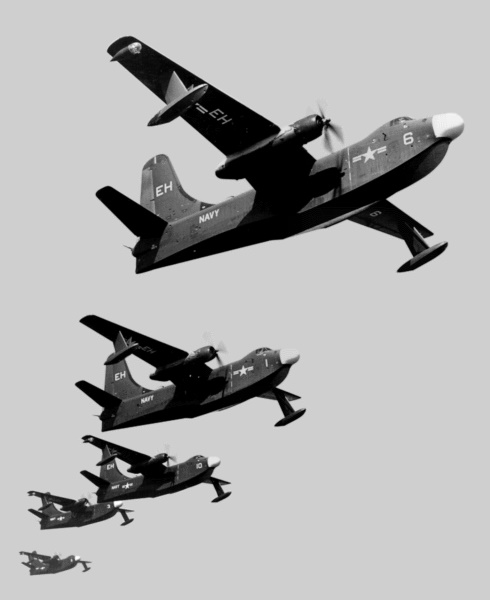
Most P5M-1s were given a comprehensive update in the late 1950s to optimize them for ASW, with gear including the Julie-Jezebel active-passive sonar system; an AN/ASQ-8 magnetic anomaly detection (MAD) system; an AN/APA-69 radio direction finding system in a small dome behind the cockpit; and an AN/APS-122 Doppler navigation radar in the tail. The modified machines were assigned the designation of "P5M-1S". Some Marlins were also fitted with a searchlight under the right wingtip, but it is unclear if this was done as part of any particular update program.
A total of 7 new-build P5M-1s was obtained by the USCG in 1954, with these machines designated "P5M-1G". These aircraft were used for the SAR role, lacked ASW gear and defensive armament, and were given a neat silver paint job. They were passed to the Navy in 1960 since the Coast Guard had obtained some more economical Grumman Albatross flying boats from the Air Force. The Navy gave the P5M-1Gs the new designation of "P5M-1T" and used them as trainers.
The XP5M-1 prototype actually remained in service well into the 1950s, being extensively modified to test improved hull designs, and being redesignated "Model 270". It was ultimately scrapped.
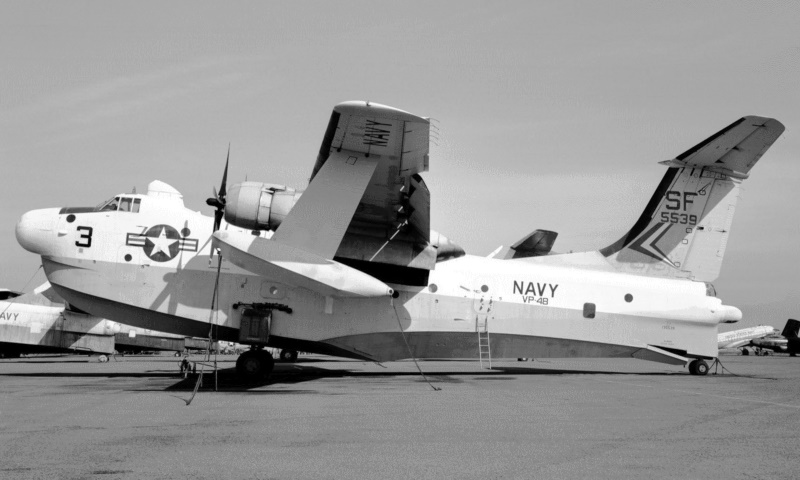
* In 1951, Martin began a major redesign of the Marlin, producing the "P5M-2 / Model 237B", which first flew on 29 April 1954. The P5M-2 had a distinctive tee tail, with a MAD boom often fitted at the junction of the tailplanes. It also had much greater fuel capacity, which increased gross weight by over 5,500 kilograms (12,000 pounds), and uprated Wright R-3350-32WA Turbo-Compound engines with 2,760 kW (3,700 HP) each to handle the greater weight. The bow chine was lowered to reduce spray, and the crew accommodations were also improved.
___________________________________________________________________
MARTIN P5M-2 MARLIN:
___________________________________________________________________
wingspan:
36.02 meters (118 feet 2 inches)
wing area:
130.6 sq_meters (1,406 sq_feet)
length:
30.66 meters (100 feet 7 inches)
height:
9.97 meters (32 feet 8 inches)
empty weight:
22,900 kilograms (50,485 pounds)
max loaded weight:
38,555 kilograms (85,000 pounds)
maximum speed:
400 KPH (250 MPH / 220 KT)
service ceiling:
7,315 meters (24,000 feet)
range:
3,300 kilometers (2,205 MI / 1,920 NMI)
___________________________________________________________________
The US Navy received 103 P5M-2s, while the French Aeronavale received 10, which equipped Flotille 27F and operated out of Dakar in West Africa. The US Navy P5M-2s were also updated to an optimized ASW specification in the late 1950s, much like that of the P5M-1S, and were of course given the new designation "P5M-2S". Some of these machines were modified in the mid-1960s to test a jet booster engine, fitted in the tail.
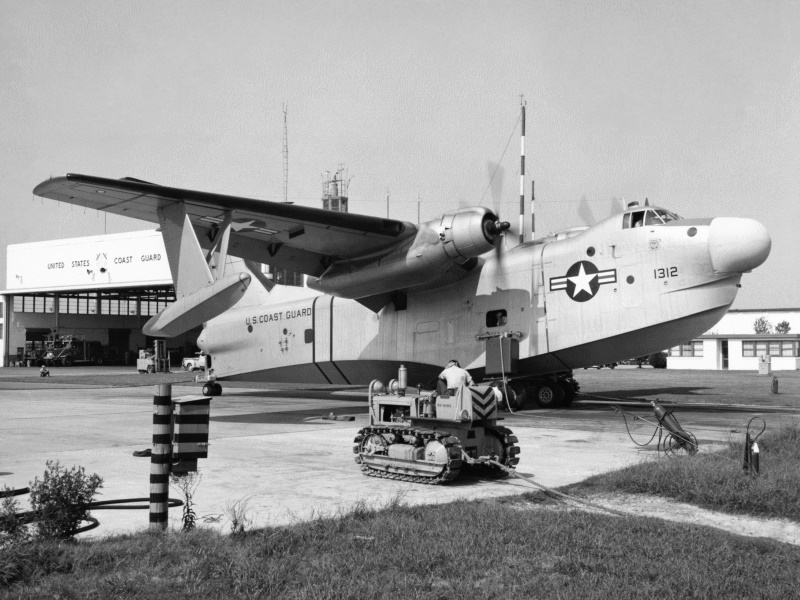
The Coast Guard received four new-build P5M-2s in 1956, which were given the designation "P5M-2G". They were configured much like the P5M-1G, being intended for SAR and lacking most combat gear. They were also phased out in 1960, being handed to the Navy for use as "P5M-2T" trainers.
285 Marlins were built in all, variants including:
* In the mid-1950s, Martin worked on a four-engine follow-on to the Marlin, originally designated the "P5M-3 / Model 313" and then, with changes including fit of a turbojet engine to provide a "boundary layer control" system that would reduce take-off run, the "P7M-1 / Model 313". A mockup was built in 1956, but that was as far as it got.
With the new multiservice designation scheme introduced in September 1962, Marlins still in US service were redesignated as follows:
Although US Navy Marlins performed coastal patrol in the Vietnam War, they were mostly out of service by 1965. The very last formal US Navy flying boat flight, with a Marlin, was in 1967. The Aeronavale operated their Marlins until 1974, when France withdrew from NATO and returned the flying boats to the US Navy.
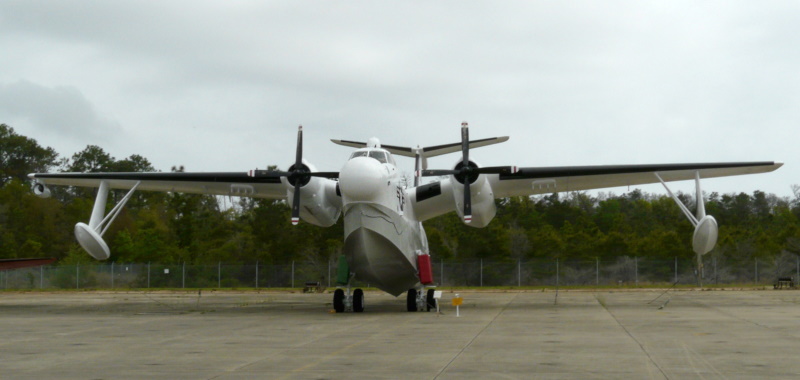
The Marlin was Martin's last full-production flying boat, and the last flying boat in operational service with any NATO nation. At least one Marlin is still in existence, at the US Naval Aviation Museum in Pensacola, Florida.
BACK_TO_TOP* In the post-World War II period, the US Air Force built up the Strategic Air Command (SAC), a nuclear strike force of long-range bombers. US Navy brass realized that the strategic nuclear mission was now of overwhelming importance, all the more so because defense budgets were being cut, and wanted to build up a Navy own nuclear strike capability to keep from being overshadowed by the Air Force / SAC.
Proposals to build a "super carrier", the USS UNITED STATES, as a floating base for Navy strategic bombers were shot down in 1949, and so the Naval Bureau of Aeronautics came up with another scheme, the "Seaplane Striking Force (SSF)". The SSF envisioned a fleet of big, jet-powered seaplanes that would not only be capable of long-range nuclear strike, but would also be useful for conventional bombing, reconnaissance, and mine-laying. Laying mines was seen as particularly important, since to reach the open seas the Soviet Navy had to pass through a number of "bottlenecks" that could be blocked by mining. The seaplanes would be able to operate from advanced areas, supported by a seaplane tender or even a submarine.
The Navy issued a request to industry in April 1951. The SSF seaplane was to carry 13,600 kilograms (30,000 pounds) of warload to a target over 2,400 kilometers (1,500 miles) from the seaplane's aquatic "base". The aircraft was to be capable of a Mach 0.9 dash at low altitude. Convair and Martin submitted proposals, with Martin winning the competition. On 31 October 1952, the Navy awarded Martin a contract for two prototypes, with the company designation of "Model 275" and the Navy designation of "XP6M-1", plus a static test article. This initial order soon led to further contracts for six pre-production service evaluation machines, with the designation of "YP6M-1", and up to 24 full-production machines, with the designation of "P6M-2". Martin gave the aircraft the name "SeaMaster"; apparently the company had run out of names starting with "Mar".
The Martin design team was led by George Trimble, an aeronautical engineer and head of the Martin advanced design department; J.D. Pierson, a hydrodynamicist; and J.L. Decker, an aerodynamicist. Using the P5M Marlin as a starting point, they developed a revised hull design, with a length-to-beam ratio of 15:1, which was felt to offer the best efficiency in both air and water. The XP5M-1 Marlin prototype was rebuilt to test the new hull design, with this test aircraft designated the "Martin Model 270".
The original powerplant was supposed to have been a Curtis-Wright turbo-ramjet engine, but that engine suffered development problems, and so the decision was made to fit the SeaMaster with four Allison J71-A-4 turbojet engines with 57.87 kN (5,900 kgp / 13,000 lbf) afterburning thrust each, mounted in pairs in nacelles above the wing near the wing roots. The J71 was a derivative of the J35 axial-flow turbojet; the J35 was used on the Republic F-84 Thunderjet, being originally developed by General Electric as the TG-180 but passed on to Allison for full production.
The wings featured a sweepback of 40 degrees and ended in wingtip tanks that served as floats; the wing had a strong anhedral droop to ensure the floats made contact with the water. The wingtip floats were also fitted with gear to help dock the aircraft. The SeaMaster was to have a pressurized cockpit and crew of four, including pilot, copilot, navigator / radio operator, and flight engineer. The SeaMaster leveraged off Martin's advanced XB-51 attack bomber design, with features such as an "all flying" tee tail and a rotating bomb bay -- in fact, early Martin concepts that led up to the SeaMaster had envisioned a seaplane derivative of the XB-51. The bomb bay flipped over in flight to expose munitions or camera payloads, and was pneumatically sealed to keep it watertight. The sole defensive armament was a remote-controlled tail turret with twin 20-millimeter cannon and fire-control radar.
* The first SeaMaster prototype was rolled out in secret on 21 December 1954, and performed its first flight on 14 July 1955, with Martin test pilot George Rodney at the controls. The flight test program revealed only one serious flaw: the engines scorched the rear fuselage, and so the use of afterburner had to be limited. The Navy publicly announced the SeaMaster in November 1955, inviting the press to witness the rollout of the second XP6M-1 prototype. Unlike the first prototype, the second prototype was fitted with operational navigation and bombing gear.
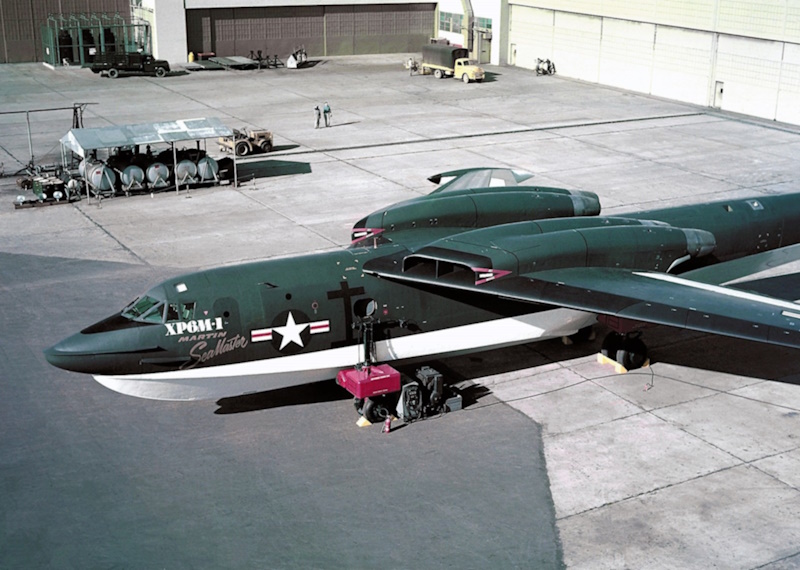
The test program continued smoothly until 7 December 1955, two days after the death of Glenn L. Martin. During a routine check flight for the first Navy pilot, the initial SeaMaster prototype crashed into Chesapeake Bay, killing all four aircrew. The post-mortem revealed a control-system fault that caused the aircraft to pitch nose down, bending its wings down and ripping them off. The second SeaMaster prototype was refitted with new flight instrumentation and ejection seats. Test flights finally resumed in May 1956. Unfortunately, the second prototype went out of control on 9 November 1956 during a flight test of a modified tail configuration. The aircraft broke up, but the crew were able to eject safely. The problem was traced down to an error in the design calculations for the tail control system.
* Despite the loss of both prototypes, the Navy still remained enthusiastic about the SeaMaster. A beaching cradle was designed to allow SeaMasters to taxi in and out of the water, and two landing ship docks, two seaplane tenders, and the submarine USS GUAVINA were sent to shipyards to refit them as SeaMaster support vessels. A home base was set up at Naval Air Station Harvey Point, near Elizabeth City, North Carolina.
The first pre-production YP6M-1 was rolled out in November 1957, with flight tests resuming in January 1958. It featured afterburning Allison J71-A-6 engines, which were visibly "toed out" to reduce the effect of exhaust blast on the rear fuselage. The engine inlets were also moved back from the leading edge of the wing, presumably to reduce water ingestion. Otherwise, it was hard to tell from the XP6M-1. Five more YP6M-1s were built in 1958 and participated in an extensive flight test program, performing practice drops of conventional and (dummy) nuclear munitions, and evaluating day and night photo-reconnaissance pallets.
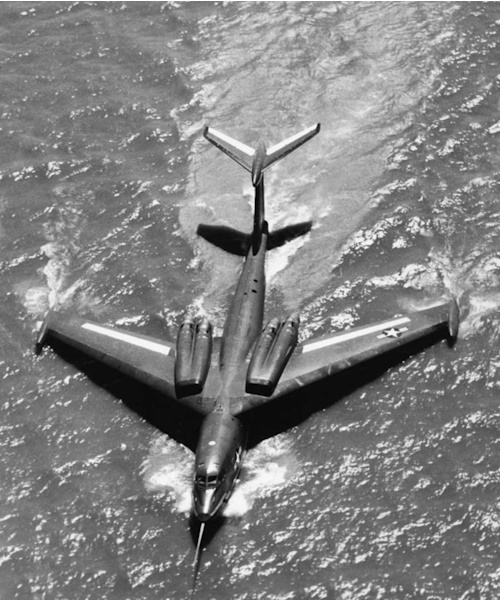
* The first production P6M-2 was rolled out in early 1959. The production SeaMaster featured more powerful non-afterburning Pratt & Whitney J75-P-2 turbojet engines with 77.89 kN (7,940 kgp / 17,500 lbf) max thrust each, providing a total increase of 53.36 kN (5,440 kgp / 12,000 lbf) thrust, and permitting a substantial increase in gross weight. The engine installation was visibly different: the engine exhausts in the XP6M-1 and YP6M-2 had been staggered, but they were parallel in the P6M-2.
___________________________________________________________________
MARTIN P6M-2 SEAMASTER:
___________________________________________________________________
wingspan:
31.37 meters (102 feet 11 inches)
wing area:
176 sq_meters (1,900 sq_feet)
length:
40.84 meters (134 feet)
height:
9.88 meters (32 feet 5 inches)
empty weight:
41,400 kilograms (91,285 pounds)
max loaded weight:
80,000 kilograms (176,400 pounds)
maximum speed:
1,010 KPH (630 MPH / 550 KT)
service ceiling:
12,200 meters (40,000 feet)
range:
3,200 kilometers (2,000 MI / 1,740 NMI)
___________________________________________________________________
The increased gross weight meant the production SeaMasters sat lower in the water, and so the wing anhedral was eliminated. The P6M-2 was fitted with a new canopy, featuring large overhead panels for a better field of view; solid-state Sperry navigation and bombing systems; and a mid-air refueling probe. A probe-and-drogue tanker kit was also developed that could be plugged into the SeaMaster's bomb bay, allowing it to be quickly converted into a tanker.
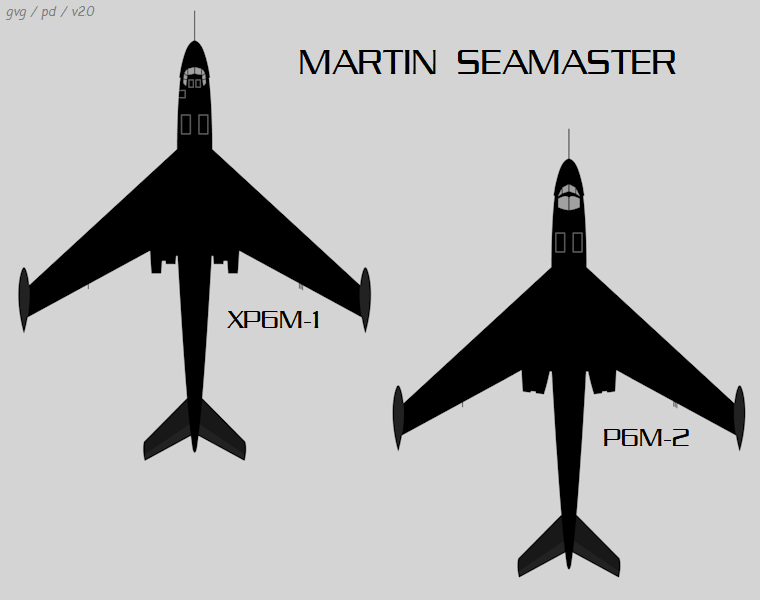
The SeaMaster was a futuristic aircraft, and its performance demonstrated that it wasn't just a pretty toy. The wings were built very strong for low altitude operation, with aluminum 2.5 centimeters (an inch) thick at the wing roots, allowing the SeaMaster to attain the Mach 0.9 requirement for "on the deck" flight. In contrast, the Boeing B-52 was only capable of Mach 0.55 at low altitude.
* Three production P6M-2s had been completed by the summer of 1959, with all-Navy crews moving them through operational conversion for service introduction in early 1960. Five more were in construction. However, the Navy had been steadily cutting back the number of production aircraft, from 24, to 18, and then to 8, and then on 21 August 1959 canceled the SeaMaster program completely. There were loud protests, since the program had cost about $400 million USD and the machine was certainly whizzy -- but in truth the SeaMaster was irrelevant, an obsolete concept. The Navy was already moving full steam ahead to a much more effective nuclear deterrent capability in the form of the Polaris ballistic missile submarine.
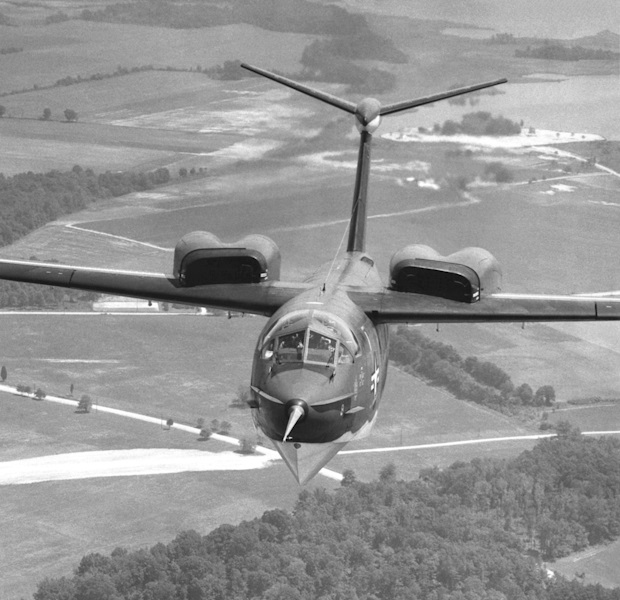
Martin tried to promote other seaplane designs, such as an eight-engine airliner version of the SeaMaster that was informally called the "SeaMistress", but the writing was on the wall. Martin formally abandoned the aircraft business to focus on missiles and defense electronics. The SeaMasters that had been built sat idle for over a year and were then scrapped, and sadly only bits and pieces of them survive.
Incidentally, Martin performed design studies early on for a nuclear-powered derivative of the SeaMaster, nuclear-powered aircraft being something of a fad in the atom-crazy 1950s. The final conclusion that nuclear power demanded a substantially larger aircraft to handle the reactor, with further investigation showing, to no surprise in hindsight, that the entire concept of nuclear-powered aircraft was impractical.
BACK_TO_TOP* As a footnote to the story of the Martin flying boats ... the Mars wasn't the biggest American flying boat to ever fly, that honor going to the one-off Hughes "H-4 Hercules", better known as the "Spruce Goose".
The story of the H-4 began in 1942, when America was attempting to send materiel across the Atlantic, and suffering painfully from German U-boat attacks. In consequence, the US War Department issued a requirement for a heavy-lift flying boat that could fly the ocean safely. The aircraft was to be made of "nonstrategic" materials, meaning in effect that it would largely be made of wood.
Henry J. Kaiser, famous for the rapidly-built "Liberty ships" used to supply the war, was interested in the requirement, but he knew nothing about building aircraft -- so he teamed up with famous aircraft designer Howard Hughes to design the giant flying boat, to be designated the "HK-1", meaning "Hughes-Kaiser 1". It would be able to carry 68,000 kilograms (150,000 pounds) of cargo, or 750 full-equipped troops, or two Sherman tanks. Seven configurations were evaluated, including twin-hull and single-hull designs with combinations of four, six, or eight wing-mounted engines. The design that finally emerged was of conventional flying-boat configuration, with eight engines. Hughes designated it the "Hughes Flying Boat (HFB) 1".
The War Department issued a contract for the HK-1 later in 1942, with three aircraft to be built in two years. The project didn't go smoothly, partly because it was low priority -- particularly after the U-boat menace was suppressed by Allied naval power -- and partly because Hughes was a finicky, erratic manager. Kaiser eventually dropped out of the program, leaving it to Hughes.
As it took shape, the H-4 was of familiar flying boat configuration, with a stepped boat hull, high wing, fixed wingtip floats, and a conventional tail arrangement. It was powered by eight Pratt & Whitney R-4360 Wasp Major 28-cylinder four-row air-cooled radial piston engines, providing 2,200 kW (3,000 HP) each. The engines drove 4-bladed Hamilton Standard variable-pitch propellers with a diameter of 5.23 meters (17 feet 2 inches).
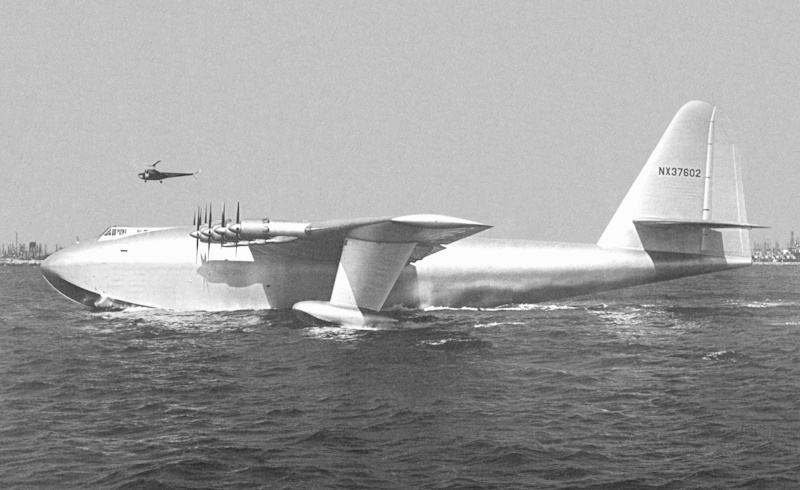
The airframe was built mostly of birch using a "Duramold" process -- a moulded laminate scheme, more like modern composite airframe construction than traditional wooden airframe construction. It required no rivets, with the laminate airframe given a coat of silver paint. The flight surfaces were so huge that a hydraulic actuation system, at the time an innovation, had to be devised to allow a pilot to move them. Engineers called it the "Birch Bitch" -- sanitized to "Spruce Goose", to the annoyance of Hughes, though it wasn't made of spruce -- and, less formally, the "Flying Lumberyard".
By the time the war ended in August 1945, the single initial prototype of the "H-1 Hercules", as it had been formally named, still hadn't flown, and the other two prototypes had been canceled. In 1947, Congress had questions for Hughes about the massive sums of money invested in the H-4, to which Hughes replied irritably:
BEGIN_QUOTE:
The Hercules was a monumental undertaking. It is the largest aircraft ever built. It is over five stories tall with a wingspan longer than a football field. That's more than a city block. Now, I put the sweat of my life into this thing. I have my reputation all rolled up in it and I have stated several times that if it's a failure, I'll probably leave this country and never come back. And I mean it.
END_QUOTE
During the congressional hearings, Hughes went back to Long Beach, California, where the H-4 had been moved -- in three parts -- for trials, with a huge hangar set up there to stow it. On 2 November 1947, Hughes took the Hercules out for taxi tests, accompanied by a good number of flight crew and engineers, plus a group of journalists; 36 people were on board. After two taxi tests, some of the journalists left; on the third, Hughes took the H-4 into the air for 26 seconds. He was then able to at least tell Congress the thing could fly.
___________________________________________________________________
HUGHES H-4 HERCULES (PROJECTED SPECIFICATIONS):
___________________________________________________________________
wingspan:
97.82 meters (320 feet 11 inches)
wing area:
1,062 sq_meters (11,430 sq_feet)
length:
66.65 meters (218 feet 8 inches)
height:
24.18 meters (79 feet 4 inches)
empty weight:
113,400 kilograms (250,000 pounds)
loaded weight:
181,000 kilograms (400,000 pounds)
cruise speed:
400 KPH (250 MPH / 220 KT)
service ceiling:
6,400 meters (20,900 feet)
range:
4,800 kilometers (3,000 MI / 2,600 NMI)
___________________________________________________________________
It never flew again. It remained in a hangar in Long Beach, being kept in flying condition, until Hughes died in 1976. After fussing for a few years, the H-4 was acquired by the Aero Club of Southern California, which eventually later put the aircraft on display in a large geodesic dome next to the QUEEN MARY ship exhibit in Long Beach. In 1988, Disney Corporation acquired properties in Long Beach, including the geodesic dome and the H-4, as part of a "Port Disney" project. That project fell through, with the Aero Club then going through an extended fire drill to find a new home for the H-4.
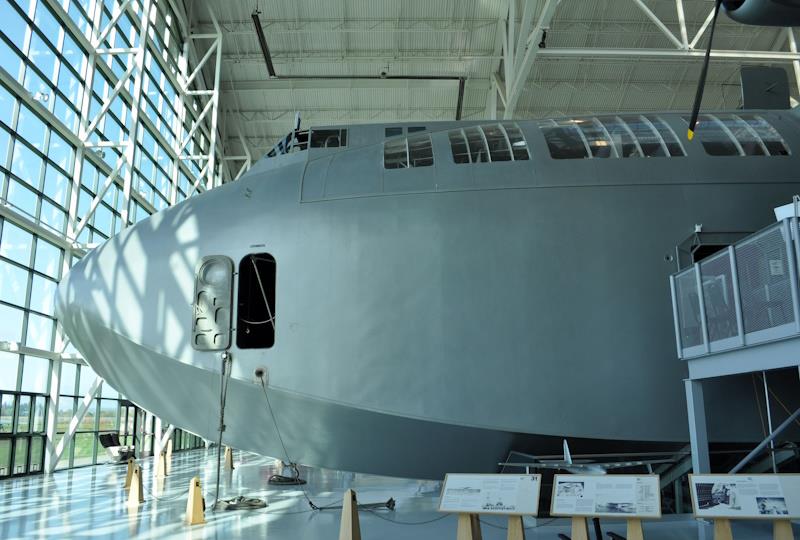
Ultimately, it was acquired by the Evergreen Aviation & Space Museum in McMinnville, in rural Oregon south of Portland. The H-4 was dismantled and transported by barge, train, and truck to the museum, the transfer taking over four months, being completed in early 1993. The Spruce Goose was reassembled and remains on display there.
BACK_TO_TOP* Sources include:
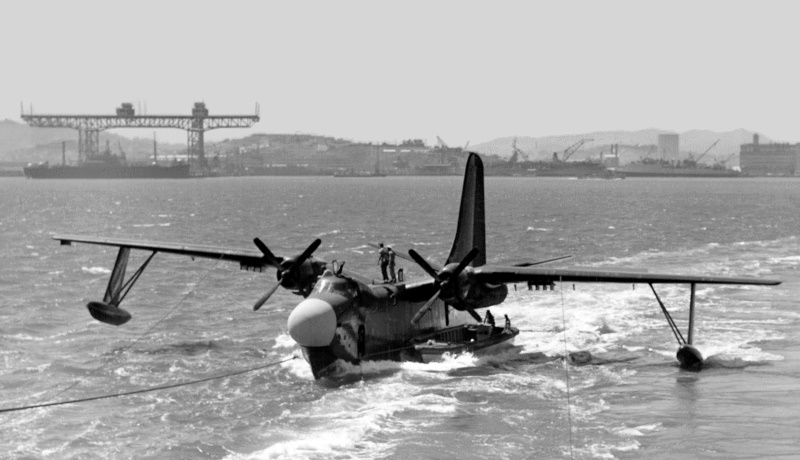
* Illustration credits:
* Revision history:
v1.0 / 01 apr 97 / Originally only covered the Mars. v1.1 / 23 feb 99 / Review & polish. v2.0.0 / 01 feb 03 / Added Mariner & Marlin, updated. v2.0.1 / 01 apr 03 / Minor typo fixes. v2.0.2 / 01 jun 04 / Fixed a few embarrassing bugs. v2.0.3 / 01 jun 09 / Review & polish. v2.0.4 / 01 jun 11 / Review & polish. v2.0.5 / 01 apr 13 / Corrections on Marlin avionics. v2.0.6 / 01 apr 15 / Review & polish, section consolidations. v2.0.7 / 01 mar 17 / Review & polish. v2.0.8 / 01 feb 19 / Review & polish. v2.1.0 / 01 aug 21 / Illustrations update. v3.0.0 / 01 dec 23 / Added P6M SeaMaster, went to 2 chapters. v4.0.0 / 01 apr 24 / Added Spruce Goose. (+)BACK_TO_TOP
